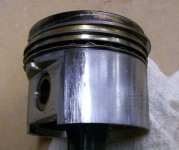Jeff_Sigrist
Member
Offline
I have about 6,000 miles on the rebuild of my 1275. This is a .040 overbore with a Kent 266 cam and dished 3 ring pistons.
The initial 3,000 miles I ran Valvoline 20w-50 racing oil. I then switched to mobil 1 synthetic. We recently drove to Florida, putting about 2,000 miles on pulling a 500 lb trailer. This was all freeway, with a lot of miles at 4,000+ rpm. On the way back I started having a knock. The oil pressure never changed so I drove it the rest of the way. Since the rebuild the engine has never overheated, or been past 5,000 rpm.
I finally had time to tear it down today and found that #4 piston has collapsed. The skirt is about .015 undersized compared to the others. I could actually see it rock as I turned it over once I had the head off. The wrist pin is also binding in the piston when you rotate it. Fortunately it looks like the scuffs in the cylinder will hone out. They'll have to as I am not going to re-bore it at this point. Everything else I have looked at so far looks good.
Now to locate a piston and get this back together for Missouri.
So, what causes a piston to collapse? Is there anything else I should look at which might be related to this before I button it back up?
Thanks,
Jeff
The initial 3,000 miles I ran Valvoline 20w-50 racing oil. I then switched to mobil 1 synthetic. We recently drove to Florida, putting about 2,000 miles on pulling a 500 lb trailer. This was all freeway, with a lot of miles at 4,000+ rpm. On the way back I started having a knock. The oil pressure never changed so I drove it the rest of the way. Since the rebuild the engine has never overheated, or been past 5,000 rpm.
I finally had time to tear it down today and found that #4 piston has collapsed. The skirt is about .015 undersized compared to the others. I could actually see it rock as I turned it over once I had the head off. The wrist pin is also binding in the piston when you rotate it. Fortunately it looks like the scuffs in the cylinder will hone out. They'll have to as I am not going to re-bore it at this point. Everything else I have looked at so far looks good.
Now to locate a piston and get this back together for Missouri.
So, what causes a piston to collapse? Is there anything else I should look at which might be related to this before I button it back up?
Thanks,
Jeff

 Hi Guest!
Hi Guest!

 smilie in place of the real @
smilie in place of the real @
 Pretty Please - add it to our Events forum(s) and add to the calendar! >>
Pretty Please - add it to our Events forum(s) and add to the calendar! >> 

